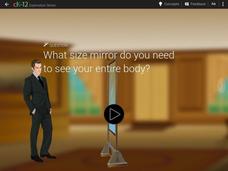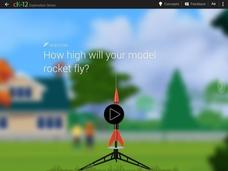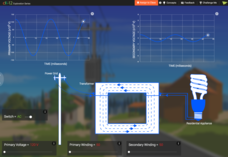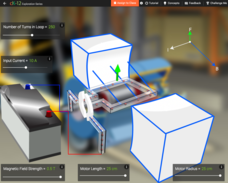CK-12 Foundation
Prom Night
Create the perfect prom night image using the Law of Reflection! An interactive lesson explores angles of reflection when looking in a full-length mirror. Learners change the distance from the mirror and length of the mirror and watch...
CK-12 Foundation
Violin
Learners explore the science of sound by considering the characteristics that make unique sounds. Through an interactive simulation, they adjust tension and string size and view the corresponding wavelength and amplitude changes.
CK-12 Foundation
Bow and Arrow
Where does the energy of an arrow come from? Is it from the person, the bow, or somewhere else? A simulation allows scholars to adjust the stretch distance and the elastic constant in order to understand where the energy comes from, what...
CK-12 Foundation
Hot Air Balloon
How can people control a hot air balloon? The simple simulation allows scholars to adjust the payload mass, burner, and vent position on a hot air balloon and observe the changes in velocity and altitude over time. Challenge questions...
CK-12 Foundation
Horse and Cart
Can a horse pull more than its weight? A simple simulation answers this question and more. Pupils adjust the mass in a cart, the mass of the horse, the acceleration of the horse, and the angle of the tension rope between the horse and...
CK-12 Foundation
Yo Yo
Does a yo-yo descend at the speed of gravity? The simulation explores angular speed and torque as a yo-yo is moved through a standard rotation. Scholars control the size and style of the yo-yo as well as the throwing speed. Challenge...
CK-12 Foundation
The Marina
Breakwaters offer marinas and beaches protection from large ocean waves, but how do they work? Scholars observe wave patterns and wave amplitude during the simulation. They control the number of openings, width of openings, distance...
CK-12 Foundation
Scuba Training
How does a scuba diver control whether they sink or float? Scholars observe the relationship between absolute pressure and depth below the surface in an undersea simulation. They control the diver size and depth to center of mass to...
CK-12 Foundation
Heat Engine
How can heat power an engine? Scholars observe a heat engine working and control variables to determine the most efficient setup. They change the amount of heat input as well as the stroke length. Energy efficiency numbers prove the...
CK-12 Foundation
Cassegrain Telescope
How does a telescope magnify images? Learners first watch a tutorial explaining the basic construction of a telescope. Then they interact with a simulation that allows for changes in the location and diameter of the reflecting mirrors....
CK-12 Foundation
At the Crossroads
Young scientists investigate methods of comparing standard and metric units with a technology-enhanced lesson that builds a connection between conversion ratios and the corresponding units. The simulation allows learners to...
CK-12 Foundation
Newton's Cannon
Gravity does more than keep our feet on the ground — it holds a satellite in orbit, too. Help learners understand the effects of gravity on an orbiting object through a simulation activity. Individuals adjust a launch speed and watch as...
CK-12 Foundation
Tire Pressure
Learners use an interactive simulation to explore the connection between force and air pressure. They adjust the mass of a vehicle and air pressure in its tires and predict the result. As the vehicle's mass increases, the tire pressure...
CK-12 Foundation
Model Rocket
Acceleration, velocity, mass, and gravity all play a role in the motion of a rocket. Young scientists explore the connection among these components using an interactive tutorial. They adjust the mass and thrust force to experiment with...
CK-12 Foundation
Contact Lens
How do contact lenses work? The simulation allows young scientists to explore focal length and lens type to see how and why contact lenses work. Pupils control the focal length for an eye and a lens, the type of lens, and the distance...
CK-12 Foundation
Diamond Cut
How do jewelers tell the difference between diamonds, glass, and cubic zirconia? A sparkling simulation demonstrates how to use a ray of light to determine the substance and ideal shape for a diamond. Scholars control the material,...
CK-12 Foundation
Power Lines
How does electricity travel through power lines? The simulation demonstrates the how changes in voltage and resistance are related to the distance between power polls and the thickness of the cable. Scholars control three variables in...
CK-12 Foundation
Field Lines
The earth has a giant magnetic field caused by the liquid iron that constantly moves in the outer core. Scholars explore the magnetic fields of four different planets. The strength and alignment of the poles relates to the implications...
CK-12 Foundation
Galvanometer
In 1820, Hans Christian Orstead discovered the link between electricity and magnetism, which allows us to measure current and voltage. The simulation allows scholars to observe the inner workings of an ammeter and voltmeter as they...
CK-12 Foundation
Doorbell
What are some simple uses for an electromagnet? Scholars explore the electromagnetic circuitry in a doorbell through an interesting simulation. They control the core material, number of loops, amount of current, and strength in a spring....
CK-12 Foundation
AC Transformer
High voltage power lines deliver electricity to homes, but each home requires low voltage. How does the energy get converted so it can be used safely? Pupils explore alternating current and transformers through a simulation. They control...
CK-12 Foundation
Electric Motor
How does a direct current run a motor? Pupils control five variables in an electric motor and observe how the force diagram changes. The force, magnetic field, and current vary based on the changes in the design of the magnet and...
Curated OER
Follow The Leader - Soca Style
Here's a great warm-up activity to get your dancers up and moving. There are some very basic moves like hopping, sliding, marching, and bouncing in place. Add some hand and arm movements. Some days you could have slower music and some...
Curated OER
Setting the Story: Techniques for Creating a Realistic Setting
“It was a dark and stormy night.” Thus begins the 1830's novel Paul Clifford and, of course, all of Snoopy’s novels! Encourage young writers to craft settings for their stories that go beyond Edward Bulwer-Lytton’s often-mocked phrase...























